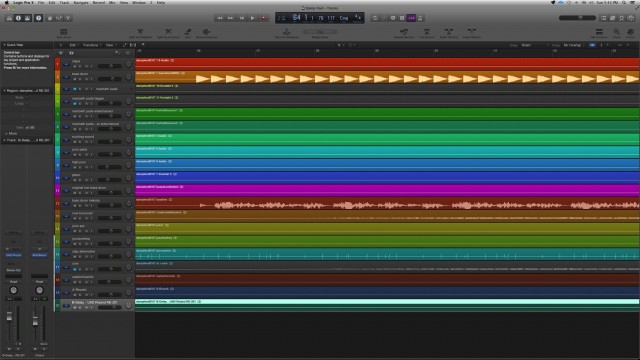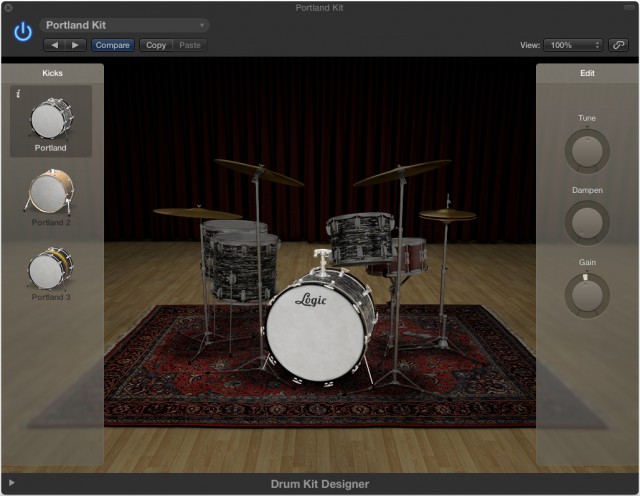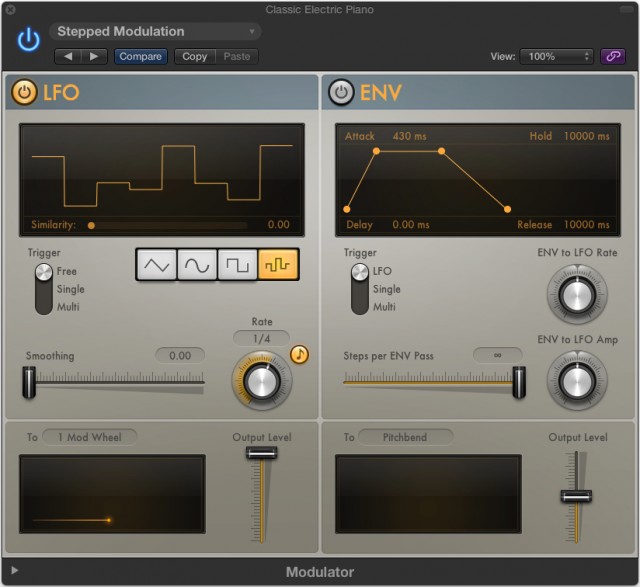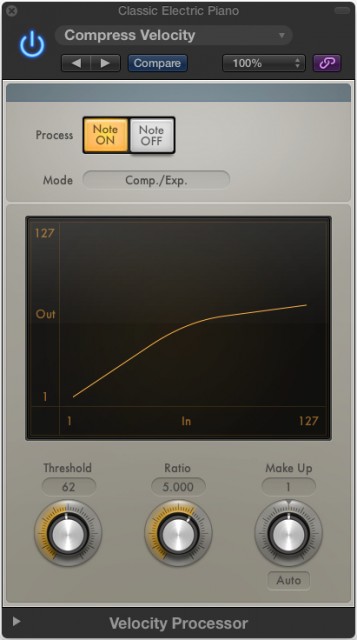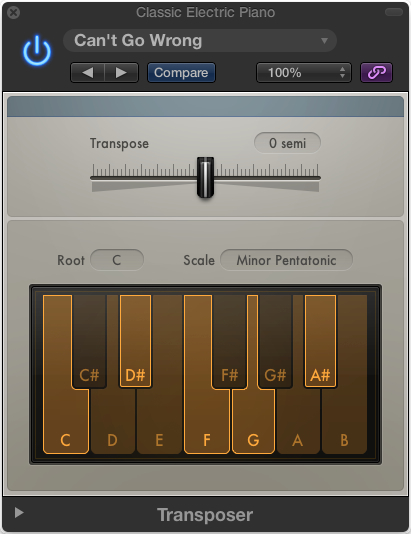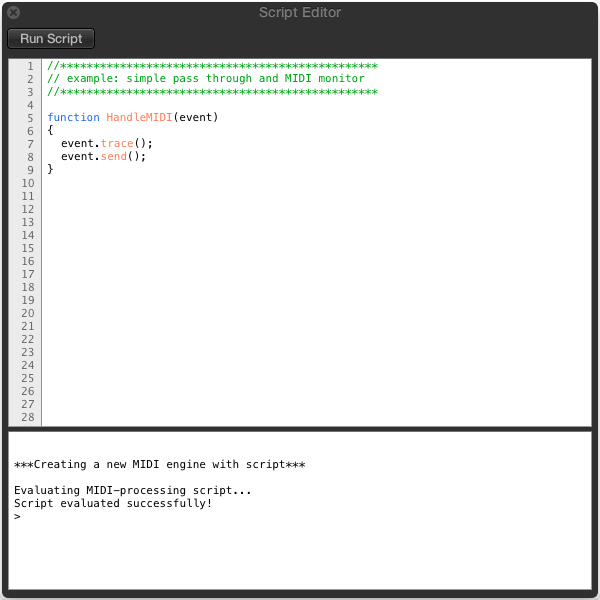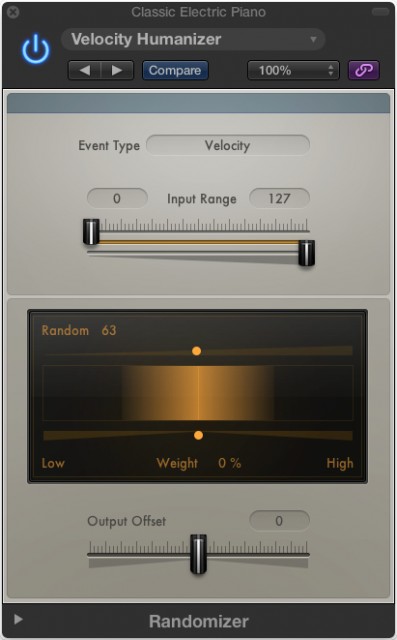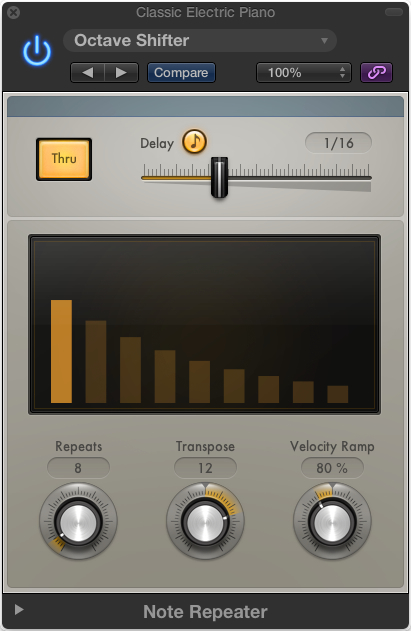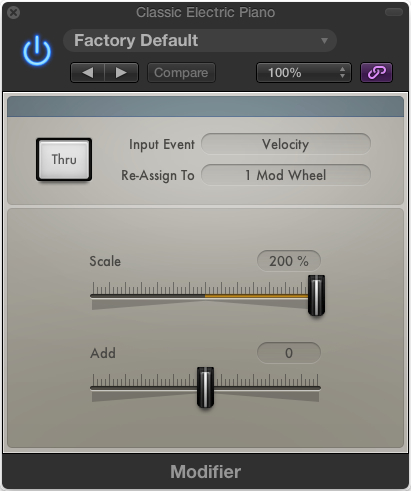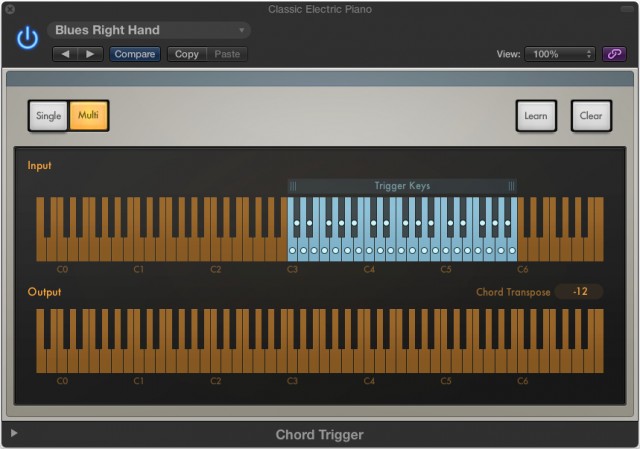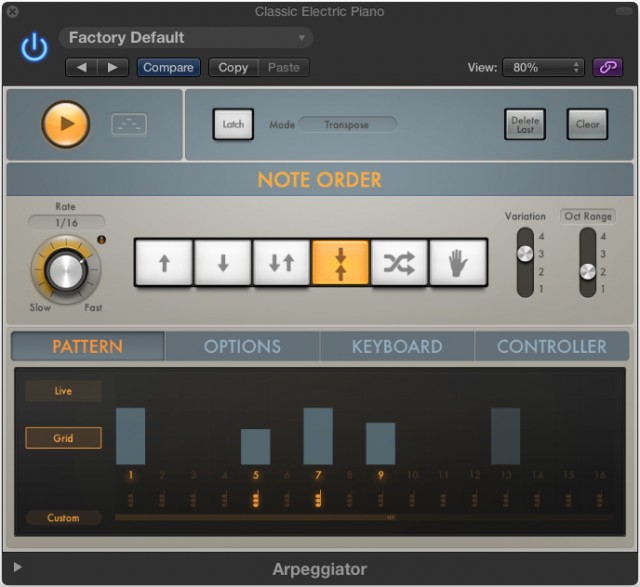It’s been four years since we saw a significant update to Apple’s flagship music production suite. But the wait today is over. Logic Pro X is here, along with MainStage 3 and a new, free companion iPad app called Logic Remote.
First, if for some reason you’re a loyal Logic user who has been dreading this upgrade, you can officially relax. As I suspected in 2011, this isn’t the sort of radical departure from previous versions of Logic some had feared. With the exception of the long-discontinued WaveBurner and Soundtrack Pro, you’ll be hard pressed to find any “legacy” feature of Logic not in the latest release. The Environment is still there, if you want it – though you’re also free to ignore it. Even old Jam Pack presets still work, and are available as an optional download. In fact, apart from Windows compatibility, you’d be able to easily upgrade from a release of Logic from many years ago. (There’s complete backwards session compatibility.)
But let’s talk instead about what is new. Logic in this release continues a beautiful interface modernization. It adds new tools of interest to songwriters and instrumentalists that make it easier to add more human-sounding drum patterns. There’s a new drum kit instrument, bass amp, pedals, and keys. There’s a deep collection of new MIDI effects. Audio editing now includes monophonic pitch editing.
And one prediction was right: the rise of the iPad has had an impact on Logic. But it comes in a controller app that you can use as an instrumental input device, mix and parameter controller, and even mobile help device.
There’s also one caveat: this release drops the 32-bit bridge for compatibility with plug-ins not yet updated to 64-bit support.
It also requires Mountain Lion.
CDM was given early access to Logic Pro X and Logic Remote, so I’ve been locked in the studio testing everything I can. This is pre-release software and therefore a preview, not a review, but I can give you some fairly exhaustive details.
Refined Interface and Mixing

Track Stacks offer powerful tools for creating everything from instrumental multis and stacks to grouped tracks for drum recordings.

Apple’s updated Library is easier to navigate. It also now includes a variety of presets that take advantage of features like Track Groups, and the Smart Control layouts for desktop and iPad.
The first thing you’ll notice about Logic is a greatly-refined interface. In terms of actual functionality and layout, it actually probably represents a smaller set of changes than the leap from Logic 7 to Logic 8. But there’s a level of detail that makes it feel like a bigger step forward in polish. (I had to refer back to Logic Pro 9 just to be sure.) As in 9, the main working window is a set of collapsible panes. But the software looks visually more appealing than ever, which apart from being aesthetically pleasing means it’s generally easier to work on long sessions. And small changes make it feel more organized. The transport bar is now at the top, Library and project panes are now in more intuitive locations, and it’s easier to toggle the toolbar.
Once you get into mixing, these changes make working feel more fluid. Some of these changes are overdue. At last you can move inserts by dragging without a modifier. A clever overlay likewise makes it easy to bypass inserts or open up their settings just by clicking. Gain reduction meters make metering easier. And there are changes like this, which I will copy verbatim from pre-release text from Apple. I think this speaks for itself — it’s the way it should have been done in the first place (and the way some other DAWs had already worked):
All components on a channel strip now reflect their position in the signal flow. The position of the meters and the send knobs also change to communicate their respective pre- or post- setting.
You can also drag tracks up and down in the arrangement, although a bug in the build I tested meant the transparent overlay didn’t always appear in the right spot. (Hopefully that’s fixed in the build released today in the App Store.)
There are also two new features that help organize work. In terms of tracks, a new grouping feature called Track Stacks makes it possible to group multiple tracks together, then control panning, mixing, and processing routings for the whole group – without mucking about with bussing. Grouping is nothing new in itself, but Apple’s implementation is especially nice, and there’s a preset system for storing your favorite patches.
For newcomers, many of Apple’s own presets make use of Track Stacks to encapsulate fairly sophisticated routings and call them up quickly. That can help people get started with production quickly – and they’re always editable later, if you like.
Perhaps the most useful addition is a small one: Quick Help displays interactive help for features throughout Logic. It works – well, exactly the way the same feature does in Ableton Live. But that’s one I’m glad to see copied.
There’s also a feature called Smart Controls, basically a set of macro knobs that can be assigned to any parameters you want. These are already mapped out of the box to Apple’s massive set of presets, but you can also use them with your own plug-in collection. They even map parameters by default, so simple third-party plug-ins will work without modification. For those who do want to delve deeper, you choose from a set of preset layouts (and fancy textured backgrounds), then choose Learn to assign the controls you want. An inspector lets you modify scaling and the like.

Smart Controls group together parameters from effects and instruments – and also map to the iPad app. As you’ll see, they even automatically pick up some third-party parameters. But you also can create and save your own custom mappings.
This all becomes more powerful because the iPad remote control app lets you touch these parameters. Other apps have had similar macro controls, but having a selection of different layouts (rather than just eight knobs in a row, or a 4×2 array), plus iPad access gives Apple’s implementation a huge edge.
So – let’s talk about that iPad app.
Logic Remote for iPad

Logic provides tap access to custom shortcuts – a bit like the iPad app Actions, but tailored to Logic.
GarageBand may not be taken seriously by every forum and comment troll, but in this case, Apple has plucked some of the best bits from GarageBand for iPad and made them available to Logic users.
Logic Remote is a wireless remote control app for mixing, parameter manipulation, instrumental input, shortcuts, and interactive help. It’s not the first time a DAW has gotten its own iPad controller app – Steinberg deserves credit as the first major DAW vendor to do that, with Cubase. And, indeed, there are some similarities between Logic Remote and Cubase iC Pro – see previous CDM coverage.
Where Apple has done something different is integrating Logic Remote with instruments. You get the interactive touch views from GarageBand, including a set of pads, piano keys, a virtual set of strings, and a chord layout. And, naturally, Smart Control layouts appear automatically. With Apple’s instruments, especially, this is a whole lot of fun, as you have instant touch access to instruments and soft synth parameters.
Unfortunately, I was sad to see that Apple hadn’t devised a touch layout for Sculpture – instead, you get some hum-drum virtual knobs. That seems an enormous missed opportunity to create something really special. And it would be one case where the iPad might best a physical input device.
Naturally, you also get access to mix and transport controls, plus the ability to jump between markers. I found I used the transport features more than any other; now it’d be hard to use Logic without the iPad nearby. Unlike Cubase iC Pro, though, there isn’t any visualization of the arrangement – only a ruler with nothing else on it. So if you haven’t set up markers, you have to look at the screen.
That’s perhaps the big problem with Logic Remote: once you get this, you want more. New Drum Kit Designer and Drummer features have big, flashy UIs on your Mac that look for all the world like iPad interfaces – but there’s no iPad equivalent. And being able to see the arrangement on the iPad seems like a must. It seems likely that future Logic updates may bring new features to the desktop and iPad remote app in parallel.
One clever feature I wanted to test but couldn’t in this pre-release: there’s an interactive help feature. It’s already useful to have documentation on the iPad, but even cooler, the iPad can dynamically update as you hover over features with your mouse. (I saw this demoed by Apple separately.)

Instrumental layouts and Smart Controls (for instruments and effects alike) appear automatically, making the connection between Mac and iPad feel fairly seamless.
Flex Pitch
Apple’s Flex Time feature was powerful already, but once you can manipulate audio freely in time, you begin to wish you could sometimes adjust pitch. Flex Pitch does that, with an interface for tweaking monophonic pitch, as seen in plug-ins like Celemony Melodyne. Again, Logic’s former rival Cubase deserves a nod for getting there first, but Logic users waiting to do this finally get the chance. Logic’s UI is especially beautiful here, with handles for each control. The results are uncluttered and easy to learn.
Apple says any monophonic content should work, from voice to bass lines. I experimented with voice and was fairly happy with the results. This isn’t just about auto-tuning: in many cases, you might just slightly, subtly tweak intonation, or try creative experimentation with shifting notes around, allowing you to re-compose after the fact. Just don’t expect too many miracles – our ears are especially sensitive to the sound of the voice, especially. But with some work, there are deep possibilities for tweaking and coloring vocal lines.
You can also export patterns to MIDI. As with Ableton Live 9, that’s a feature that can produce some interesting creative results — even when it isn’t perfectly accurate, it can be another song starter. (Unlike Live 9, which works both on monophonic melodic and percussive content in its convert to MIDI function, Logic is restricted to melodic content.)
In some contexts, Flex Pitch may replace a dedicated plug-in like Celemony’s Melodyne, and there’s no question it’s convenient having this built into the DAW. It certainly rivals the US$99 Melodyne Essential. (Significantly, I found myself using the Formant tool heavily, even apart from pitch correction, which is not included in Essential.) But Celemony’s more advanced products (and more expensive products, of course) still do a lot that Logic won’t. Flex Pitch won’t support polyphonic content, most significantly, which for now remains in Celemony’s unchallenged Direct Note Access. But even with monophonic content, you can access other advanced features for managing scale and tuning and separations and transitions between notes that are either missing or simplified in Logic. And these can justify the tradeoff of having to split your workflow between host and plug. Of course, Melodyne is available as a 64-bit plug-in, so you can always add it to Logic for heavier editing tasks.
My guess is that here this will depend on how much pitch editing is part of your day.
Update: I clarified the above passage to make it clearer how I would differentiate Logic’s built-in facility from a plug-in. We’ll have to put Cubase and Logic head to head another day.

For monophonic pitch adjustments, FlexPitch provides a rather lovely interface inside the DAW. (And yes, Cubase users, we know you had this already – but most DAWs still don’t.)
Drummer and Drum Kit Designer

Drummer is actually a lot of fun to use – rockers and songwriters wanting more dynamic backing tracks, even for practicing, will find plenty to like. But more sophisticated users can use customization and MIDI functionality to generate patterns for other purposes. Oddly, though – this iPad-looking UI isn’t on the iPad.
For singer-songwriters, composers, and the like, it isn’t always possible to get a drummer in the studio. Logic Pro X’s flashiest new features focus on simulating the drummer in the studio. Apple boasts that they turned to some major players, producers, and mixers to get the results, and while they focus heavily on rock/alternative sounds, the sounds themselves are top-notch.
Drummer is a feature that produces more dynamic results than loops alone would. Instead of repeating mindlessly in the way a loop does, a set of interactive parameters directs more human combinations of fills and different percussion.
What makes this feature fun is the amount of parameter control Apple has provided. And if you aren’t in love with sampled drums, there are two features that might make you still want to check out Drummer. One is, you can edit regions directly, generating MIDI for editing. Second, you can substitute the sound of the Apple drum kits with anything you want – including synthesized or electronic sound. I got a little carried away creating a minimal techno track using one of these presets and Klopfgeist, the infamous Logic metronome instrument. If you bug me, maybe I’ll upload it to SoundCloud. (Alternatively, if you really bug me, maybe you’ll have the fortune to stop me.)
There’s also an extensive Drum Kit Designer for mixing and matching your own kits, as you can see in the image.
New MIDI Plug-ins, Arpeggiator
When I reviewed the last big release of Logic 9 in 2009, I complained that Apple had neglected MIDI features. Boy, did they not neglect them now. There’s a set of live MIDI effects – so far, okay, long overdue. It’s the level of detail and power in these MIDI effects that sets them apart. The arpeggiator, for instance, can go from being a simple arp to a massive multi-step pattern generator with chord triggers.
They’re powerful enough, in fact, that you can finally use something friendly to a vast number of users and not the fairly-intimidating Environment, producing very sophisicated patterns and music generators. And, of course, you can use these with external MIDI gear, too.
These are best seen in the screenshots, so let’s have a look in pictures.
While finishing the review, I finally noticed something I wished I had asked Apple about – there’s now MIDI scripting. We’ve seen that in the Kontakt sampler and in DAWs like Renoise and Reaper, but MIDI scripting in Logic sounds like huge news; I’ll let you know when I find out more.
New Instruments and Effects
Logic 9 focused on guitar amp and effects simulation. Logic Pro X … focuses again on guitar amp simulation (though not exclusively – more on that below). So, the Amp Designer is now coupled by a Bass Amp Designer.
The good news here is, the Bass Amp Designer sounds fantastic. And you also get the ability to set up a Direct Box in addition to the simulation of the miked amp, and mix between direct and “wet” sound. Also, there’s now both parametric and graphic EQ on both the Amp Designer and Bass Amp Designer. Even in a crowded market of amp simulation effects, I found these hugely useful features, and of course not only for processing guitar and bass signal.
Also of use to guitarists (and the rest of us using these tools for other purposes), there’s a new tuner and a bunch of new stomp effects: Apple notes “Tie Die Delay (reverse delay), Tube Burner (tube style overdrive) Wham (pitch whammy pedal), Grit (classic distortion), Dr. Octave (sub octave enhancer) Flange Factory, Graphic EQ.”
I just wish selecting those stomp effects were easier; it’s hard to make out the different, pretty graphic icons in the window. But the sounds are nice enough.
Apple adds new instruments to the mix. They’re all bread-and-butter additions, but it’s nice to have them in your arsenal. Retro Synth is a simple virtual analog soft synth – happily not only another Minimoog-style synth, but with basic two-operator FM and wavetable modes, too. There’s also a new electric piano, clav, and B3 instrument. Back in the day, Emagic/Apple really led the industry with quality instruments here, but they had fallen behind. In the new modeled options, they’re back in the game; the instruments really do sound lovely. And of course, you can play them with the iPad, too, and not only a keyboard. (The obvious comparison in these instruments would be Ableton Live, which now has rather nice emulated keyboards and synths – though no Hammond organ.)
It goes without saying that while the mainstream tech press focuses on the look of iOS 7, skeuomorphic interfaces are alive and well in Logic. Apple did everything short of add dirt smudges to the keyboards and cigarette butts on the rug under the drums. Fans of faux woodgrain, you can still revel in an Apple product. Of course, with musicians, the reasoning is different: apart from looking nice, these designs give users depth, make interfaces easier to look at, and provide feedback on what sort of sound to expect.
More Features
There are many other smaller features I can’t cover here.
The most significant one to me is probably the ability to save particular versions and then compare, a feature Apple calls Alternatives. This combined with Auto-Save is invaluable for keeping your work safe and tweaking the final result you want. In fact, cough, an Alternatives-style feature used to exist in Final Cut Pro 7 and hasn’t made the leap to Final Cut Pro X. Ahem. Hope to see that fixed.
Other significant additions include Import/Export Final Cut Pro XML and Music XML export and a number of score enhancements.
MainStage 3 is also available as a separate US$29.99 App Store purchase, with an updated UI, support for Track Stacks, and of course support for Smart Controls – a perfect companion to that app, too. (Actually, I wonder if it will make more sense to use Logic with Logic Remote, or if a dedicated iPad MainStage control app is something we might see.)

MainStage 3 is also available today to take advantage of new Logic features. That should come as good news to celeb users like Nine Inch Nails and Paul McCartney. Photo courtesy Apple.
What Isn’t Changed – and About That 64-Bit Thing
Now, some bad news. Apple hasn’t touched UIs for almost everything else in the product. At last, MIDI has gotten some attention. But Logic’s suite of audio processing is starting to look seriously long in the tooth; other DAWs have simply moved ahead. It’s not that these aren’t usable, and indeed will be familiar to long-time Logic users. But I notice the number of built-in effects I still use has gone down dramatically in light of superior alternatives, and of course these UIs look out of place in the otherwise-refined host. Perhaps more importantly than how they look, the sound quality and functionality of some of these hasn’t kept pace as the industry has moved forward. Likewise, a lot of Logic’s instruments, while powerful, could also use a makeover; Ultrabeat in particular has a UI that … well, okay, existing Logic users know what I mean.
The other big change is dropping support for 32-bit plug-ins; only 64-bit plug-ins work. Apple has successfully motivated most AU developers to refresh their plugs. But while I wasn’t personally in any trouble on this one, years of experience writing music tech pieces tells me that right now, somewhere out there, someone is screaming. And that might be reason to hold out on the upgrade.
First Impressions
It’s the same as it ever was: now as always, it’s impossible to recommend one DAW for everyone. The reality is, there are a number of really terrific offerings. All of the significant players have gems, all of them weird quirks and oversights, all of them different areas of emphasis.
What Logic now offers is one of the most refined user interfaces available, as far as the primary window for mixing and arrangement. Because you spend so much of your time looking at that UI, that’s no small question. And it also offers uniquely good tools for producers looking to simulate drums and bass and guitar effects and amps in the box, coupled with some nice options for people writing songs and creating music and strong pitch offerings. On the electronic producer side, the new set of MIDI tools is simply spectacular candy.
It’s clear where Logic needs to improve next – it’s time for Apple to dig through that collection of audio processors.
But as a $199 DAW, Logic is a terrifically-strong choice on the Mac. As always, you’ll want to weigh it against other tools and see which you like and which fits for your needs.
For existing users, though, unless you need 32-bit compatibility, I think upgrading is a no brainer. Just be aware that, as an App Store app, the upgrade is also … $199. I’m sure that’ll make some people angry, though that is a weird story: it’s a perfectly-normal upgrade price, it just happens that the price for the whole product is lower than many rivals, and the App Store doesn’t offer upgrades.
I just know I find Logic is one of those tools I come back to when I want to feel musically productive – and that I’m glad to dump 9 for X. I hope we’ll look a little more at some of the music tools in there soon, as I’m using them in the work I’m making.
http://www.apple.com/logic-pro/
